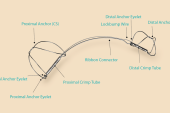BATMAN Signals New Way to Prevent LVOT Obstruction in High-Risk TMVR Patients
The technique isn’t standardized yet, but it’s simpler and potentially shorter than the LAMPOON approach.

WASHINGTON, DC—In patients undergoing transcatheter mitral valve replacement (TMVR), a balloon-assisted technique shows promise as a way of modifying the anterior mitral leaflet to prevent left ventricular outlet tract (LVOT) obstruction.
In the investigator-initiated registry study, there was a 93% rate of procedural success and freedom from LVOT obstruction.
The balloon-assisted anterior mitral leaflet modification (BATMAN) technique may be a reasonable alternative to another more complex way of lacerating the anterior mitral leaflet, known as LAMPOON, given the comparable results, said Gennaro Giustino, MD (Gagnon Cardiovascular Institute, Atlantic Health System, Morristown, NJ), who presented the results here last week at the Society for Cardiovascular Angiography and Interventions (SCAI) 2025 Scientific Sessions.
BATMAN is a more streamlined technique than LAMPOON, said Giustino. Whereas LAMPOON involves electrosurgical traversal and laceration, BATMAN requires only electrosurgery for the traversal followed by balloon-assisted laceration.
The findings are important as the BATMAN approach has been implemented in clinical practice fairly widely despite the lack of clinical data or early-stage testing to support its efficacy, he added. LAMPOON, meanwhile, has fallen out of favor with many operators due to the complexity of performing it and the length it adds to procedure times.
“In this international, multicenter cohort study, BATMAN was technically feasible, associated with short procedural times, and highly effective in enabling TMVR in patients at high risk of LVOT obstruction,” Giustino said.
One of the ways BATMAN simplifies the procedure, as well as access, is that the operator uses the same wire to transverse the leaflet, make the laceration, and deploy the valve. Across the study’s 12 participating centers in the US, Canada, and Italy, however, there was no standardized protocol or guidelines for doing BATMAN, with the execution of the technique left to the discretion of the operators.
“Over the last year there has been a proliferation of papers describing iteration of the same technique. Everyone is doing the same thing in a different way using different techniques. I think this actually reinforces the external validity of the findings, because it’s real-world experience,” Giustino told TCTMD.
The sample sizes of the different ways that operators performed BATMAN were too small to draw any conclusions about whether one way was more effective than another, he added.
This is a relatively early experience with this technique, so we need hundreds of more cases by dozens of more operators. Gregg Stone
“This is a relatively early experience with this technique, so we need hundreds of more cases by dozens of more operators,” Gregg Stone, MD (Icahn School of Medicine at Mount Sinai, New York, NY), who was a panelist during the late-breaking trial session, told TCTMD.
“I do think ultimately it will become standardized, but even then, there’ll be some variability from operator to operator,” he added. “The anatomy of the problem you’re trying to solve is variable, depending on the length of the anterior mitral leaflet or the degree of calcification. So, you’ve got to have some flexibility in how you apply the technique to solve each individual problem. With percutaneous coronary interventions and structural interventions, operators are always thinking on their feet, and this is a good example of that.”
Stone added that while the data appear promising, it’s impossible just yet to say whether BATMAN is better or safer than LAMPOON.
High Efficacy and Safety Reported
The study, conducted by the BATMAN Collaboration, included 42 patients (mean age 78 years; 70% women) at high risk of LVOT obstruction. Nearly 90% had NYHA class III or IV HF, and all were at high or extreme surgical risk with a median STS score of 10.2%. Mitral valve regurgitation was severe in 40.5%, and mitral valve stenosis was severe in 55%. Indications for transcatheter mitral valve replacement were a failed surgical valve in 31%, a failed surgical ring in 45%, and severe mitral annular calcification (MAC) in 27%.
The median traversal to laceration time was 16 minutes, the mean laceration to valve deployment time was 8 minutes, and the total fluoroscopic time was 40 minutes. According to Giustino, all of these are shorter than what has previously been reported in the LAMPOON IDE trial.
Leaflet traversal and balloon laceration were successful in all cases, with no residual LVOT obstruction. The most common valves implanted were the 26-mm and 29-mm balloon-expandable Sapien 3 (Edwards Lifesciences).
By group, procedural success and freedom from LVOT obstruction (LVOT mean gradient > 50 mm Hg), the primary efficacy endpoint, was highest in the valve-in-ring group at 100% and lowest in the valve-in-MAC group at 80%.
The primary safety endpoint, an in-hospital composite of death, stroke, or major cardiac structural complications according to the Mitral Valve Academic Consortium criteria, occurred in 9.8% of patients.
Three patients died, with all three deaths unrelated to the technique. Two occurred in the valve-in-MAC group and one in the valve-in-valve group. There were no primary safety events in the valve-in-ring group. No cardiac structural complications related to the technique were reported, there were no cases of stroke, and none of the patients required repeat mitral valve intervention or surgery.
There also were no instances of mitral curtain injury, “although I would not exclude that it could be a possible complication of the technique since it’s a balloon-induced laceration and sometimes that could be unpredictable,” Giustino added.
Speaking from the audience following the presentation, Tarek Helmy, MD (Ochsner LSU Health, Shreveport, LA), another study investigator, noted that BATMAN isn’t necessarily a replacement for LAMPOON.
“There’s room for both procedures and there are certain patient populations that would benefit from either/or,” he said. “I think of them as complimentary techniques rather than competing techniques. It’s nice to have options and alternatives to allow a larger portion of patients to be treated with these technologies.”
L.A. McKeown is a Senior Medical Journalist for TCTMD, the Section Editor of CV Team Forum, and Senior Medical…
Read Full BioSources
Guistino G. Balloon-Assisted translocation of the mitral anterior leaflet to prevent outflow tract obstruction during transseptal transcatheter mitral valve replacement: BATMAN collaboration. Presented at: SCAI 2025. May 2, 2025. Washington, DC.
Disclosures
- Giustino reports serving as a consultant and proctor for Edwards Lifesciences.





Comments